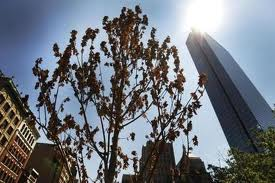The root of Boston’s tree planting problems
By Doug Struck
Globe Correspondent
Boston will become cool and green by planting 100,000 trees before 2020, Mayor Thomas M. Menino promised in April 2007. He said it “will make people feel better about where they live.”
So, halfway to the deadline, how’s it going?
That’s unclear. The city’s official Climate Plan Action Update 2011 said a comparatively meager “4,000 new trees, public and private” have been planted since 2007, and acknowledged “progress toward the 2020 goal has slowed.”
Calls for an update to the city’s Parks and Recreation Department were referred to theBoston Natural Areas Network, the non-profit now running the “Grow Boston Greener” program.
Jeremy Dick, who is in charge of the program, said the city’s figure sounded low. He said he thought “20 to 25,000” trees have been planted, a five-fold multiple of the city’s figures, but still off the goal by half. He could not explain the discrepancies, and said an accurate tally was made in spring 2012. But he declined repeated requests for that accounting, saying, “I’m not sure a story on the problems would be positive.”
Whatever the total, Tabatha White is toiling away, trying to plug the holes in the cityscape. She is a forester and tree planting coordinator for the parks department. Whenever anyone calls the city with a request, or she sees a vacant spot, she checks out the surrounding overhead wires, measures for handicap access on the sidewalk, picks from about 20 native species, and calls in the backhoe.
Last fall she planted about 700 trees, she said; this spring she hopes to hit 900.
It’s a struggle to make an urban environment green, she said. Many spots are not suitable. The city’s bustling development fells others. And about five percent of her plantings die from natural causes—“if you can call living in a sidewalk natural,” she says.
“I don’t like seeing the dead ones,” White said. “I live here in the city. My eyes are always open for open pits, whether I drive or ride or run, or go out for the evening. I feel really good when I can go back there and see that I’ve planted a tree.”
The mayor’s goal was among an array of programs to respond to climate change. Increasing the urban “canopy” would absorb carbon dioxide, help control storm water runoff, cool buildings and sidewalks, and look better, Menino said.
One of the threats to the tree plantings, though, is the city’s leaky gas pipes. Nathan Phillips, a professor in the Department of Earth and Environment at Boston University, led a study in 2011 that documented 3,300 natural gas leaks from the aging infrastructure.
Natural gas is mostly methane, and starves tree roots of needed oxygen. “It’s a contributing factor” in tree mortality, Phillips said. “It’s detrimental to their health.”
Phillips says such the city is just beginning to come to grips with the gas leaks. But “overall, in terms of Boston going ‘green,’ what the mayor has done is tremendous,” Phillips said. “Having said that, there’s always room for improvement.”

